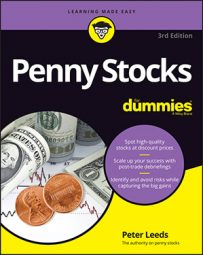- Limit orders
- Market orders
Limit orders
When you place a limit order, you set the price you're willing to pay for the shares you want to buy. For example, you can place a limit order for 200 shares of a stock at 65¢ per share. You will get as many shares as are available at 65¢; if shares happen to be selling for less than 65¢, you will get them for the lower price.However, if the shares have an asking price of 66¢ or higher, your trade order will not take place. That is, of course, unless one of the sellers lowers his asking price down to your limit price of 65¢. With limit buy orders, your trade may not take place if your bid price isn't high enough, but you will never pay a penny more than your stated price. Likewise, with a limit sell order, you will only sell the shares if the buyer meets your price; otherwise, no trade takes place.
You pay a full commission to your broker for each day that you execute a portion of your trade order. For example, if you use a limit order to purchase 10,000 shares of ABC stock, and you get 4,000 shares on day one and 6,000 shares on day two, you will be charged two separate trading commissions, one for each day. However, you won't be charged a commission for those days in which your open order doesn't result in any shares trading hands. For example, if you have an order to sell 3,000 shares, but none end up selling at the price you specified, you won't be charged a commission because you didn't sell any of the stock.
Due to the price volatility in penny stocks, the small size of the underlying companies, and the limited trading activity in the shares, it's a good idea to use limit orders when buying and selling penny stocks.
You should be aware of some potential drawbacks when using limit orders to trade penny stocks:- Low availability at your limit price: Penny stocks generally have much lower trading activity than blue-chip or large stocks, so you may only get part (or none) of your order filled.
- Multiple commission charges: Because limit orders are often only partially filled, the orders are subject to commission charges from your broker for each day your order results in shares changing hands.
- Wide spread between bid and ask prices: Placing a limit order (or knowing what price to buy or sell shares at) is an additional step for penny stock traders. If a penny stock is bid at 45¢ and the ask is 70¢, that leaves a large price spread of 25¢ between what buyers want to pay and what sellers are willing to take in exchange for their shares. You need to decide a price at which to trade shares. You may want to use the current bid and ask as a guide, but you may even want to go outside of those ranges if your analysis tells you to do so.
Limit orders aren't generally the default among brokers, so you need to make a point of selecting limit prices (or instructing your broker appropriately) when you want to enter a trade. Often this involves entering a price you're willing to buy or sell shares at when you place your order through your online broker. However, instructions can differ from one online broker to the next, so make sure that you understand the type of trades you're entering.
Market orders
When you place a market order you agree to pay the best available price for a stock. For example, if a penny stock has an asking price of 65¢, when you place a market order you agree to pay 65¢ for that stock.Market orders are the default for your broker. Unless you specifically choose to trade with a limit order, you're making a market order.
The downside of placing market order is that you can't control the price at which you trade the shares. The upside to market orders is that you get all the shares you try to buy. A market order is simply saying that you accept the best available price. Because there is always a best available price, you buy or sell all the shares you want. You just may end up paying much more for them, or receiving far less, than you expected.Don't use market orders to trade penny stocks. Here are the reasons why:
- Low availability at the asking price: Penny stocks generally have far fewer buyers and sellers, and much lower dollar amounts in total daily trading, so there may not be a lot of shares available for purchase. If you buy more shares than are for sale at the lowest asking price, your purchase order keeps going up to the next lowest asking price, which can be much higher than the previous price. For example, if you order 200 shares of a penny stock with an asking price of 65¢, but there are only 100 shares available at that price, you may be stuck paying 70¢, 95¢, or even more for the remaining 100 shares.
- Low trading volume: Many penny stocks are prone to very low daily trading activity. This means that any significant buy (or sell) order may be enough to push the prices up (or down).
- Wide spread between bid and ask prices: Even if the last trading price was 45¢, you end up paying the lowest available asking price. That price may be 45¢, or due to the generally large spreads between bid and ask prices in most penny stocks, it may be something much higher.

